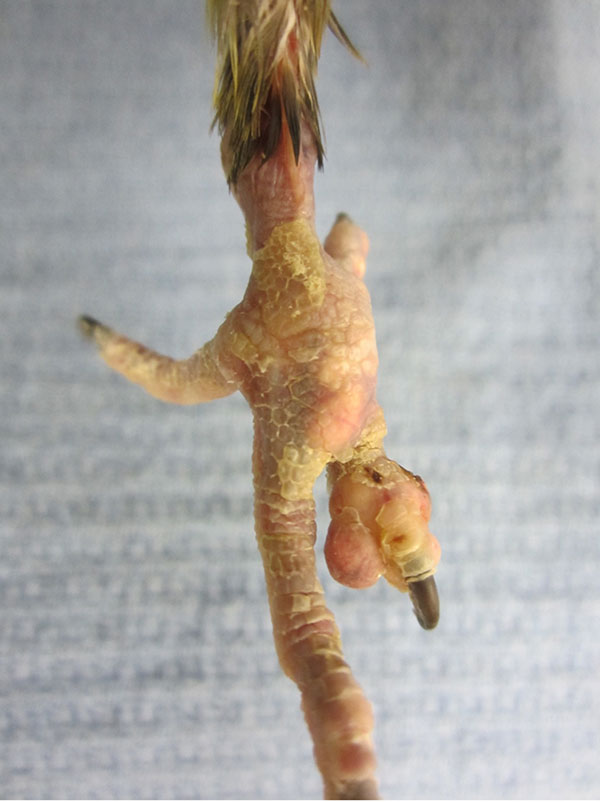Gout tophi deforming the foot of an advanced age male cockatiel. Mass aspiration can be performed to identify the swelling’s cause.
Gout isn’t just a disease of medieval royalty; many reptile and avian patients are at risk of this disease presentation!
Gout is the deposition of uric acid crystals in tissues and is often (but not always) associated with chronic renal failure. Some classic presentations are joint swellings (tophi) in an older cockatiel or budgerigar (see above). However, because crystal deposition can occur in any tissue (example: pericardium, liver), the clinical presentations can be varied.
A diagnosis of gout should be suspected in any avian or reptile patient with an elevation of uric acid. As a reminder, most birds and many reptiles are uricotelic, or excrete uric acid as their final nitrogenous waste breakdown instead of blood urea nitrogen.
Making a Diagnosis
Although there is no set rule of what blood concentration of uric acid may lead to gout, elevations of uric acid should spark a degree of concern. A definitive diagnosis of gout can be made by finding uric acid crystals in cytologic samples of tissues (typically joint aspirates).
Uric acid crystals can be challenging to find under the microscope if you don’t know what you are looking for: the crystals are best appreciated on an unstained slide under low light conditions that allow for high contrast. So, drop the condenser, reduce the light, and narrow your iris aperture to create the best chance for seeing these spikey crystals.
They can be observed singly or in large clumps, with a high degree of variability in size. They will almost always be thin and needle-like in appearance. There are often inflammatory cells associated with the crystals, so be prepared to see some heterophils and macrophages as well.
How to Treat
When diagnosed antemortem, there are several therapies that can help manage gout, reduce crystal deposition, and, in some cases, dissolve crystals already in the tissue.
- Allopurinol can reduce blood uric acid levels, and thus reduce the risk of developing more gout tophi in tissues. We usually recheck blood uric acid about two weeks after starting this medication.
- Colchicine increases uric acid solubility and, after the start of therapy, tophi often reduce in size and severity.

Work with your favorite compounding pharmacy to get these medications made into tasty suspensions for your patients to improve compliance. Additional therapies should focus on maintenance of hydration, multimodal analgesia that does not rely on non-steroidal anti-inflammatories, and correction of husbandry deficits, particularly nutritionally related. There are suspected links between chronic hypovitaminosis A and renal degeneration in many species (parrots, insectivorous reptiles like leopard geckos and chameleons), so addressing deficits is prudent.
What’s the Prognosis?
The prognosis for the patient diagnosed with gout is based upon multiple factors. High among these factors is the underlying cause for the presentation. For instance, a Jackson’s chameleon that develops gout secondary to a smoldering diffuse bacterial nephritis may require extensive diagnostics to achieve this diagnosis and, without treating the underlying infection, will be unlikely to survive very long. However, older cockatiels suffering from chronic renal failure from renal degenerative lesions may be managed for several months to years with supportive measures and dedicated clients.
Getting to the bottom of these diagnoses with a renal sample may be challenging to impossible in some cases, limiting our capabilities to provide a specific diagnosis in many situations. Further, articular gout (uric acid crystal tophi limited to the joints or peri-joint spaces) may be incredibly uncomfortable, while visceral gout, characterized by gout tophi in the tissues of the viscera, can have severe metabolic consequences and may not be able to be diagnosed easily antemortem.
Despite these limitations, our practice makes the diagnosis of hyperuricemia with or without gout in companion birds and reptiles frequently. Even when clients don’t have the capabilities or interests in pursuing diagnostics such as renal biopsy and contrast-enhanced computed tomographic imaging, we see moderate to high success rates with provision of the antigout medications mentioned above and a holistic approach to patient comfort.
As always, the zoological medicine service is available to consult with you about a case you have diagnosed with gout to chat through available therapies and additional diagnostics.
Email zoomed@vetmed.illinois.edu or call 217-333-5311 to reach us.
By Krista Keller, DVM, Dipl ACZM, and Jennifer Trail, CVT




